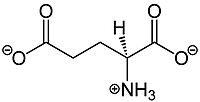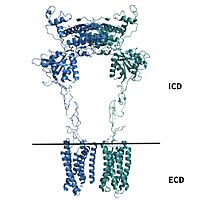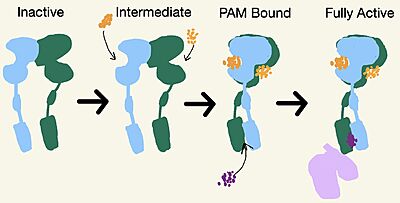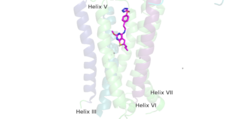Sandbox Reserved 1703
From Proteopedia
(Difference between revisions)
| Line 4: | Line 4: | ||
==Introduction== | ==Introduction== | ||
| - | '''Metabotropic glutamate receptors (mGluRs)''' are found in the central nervous system and play a critical role in modulating cell excitability and synaptic transmission <ref name="Lin">PMID: 34135510</ref>.[https://en.wikipedia.org/wiki/Glutamate_(neurotransmitter) Glutamate], shown in Figure 1, is a negatively charged polar amino acid that is the main neurotransmitter in the brain. Glutamate activates 8 different types of metabotropic glutamate receptors<ref name="Seven">Seven, Alpay B., et al. “G-Protein Activation by a Metabotropic Glutamate Receptor.” Nature News, Nature Publishing Group, 30 June 2021, https://www.nature.com/articles/s1586-021-03680-3</ref>. '''Metabotropic Glutamate Receptor 2 (mGlu2)''' is a member of the [https://en.wikipedia.org/wiki/Class_C_GPCR Class C GPCR]Family and can further be classified into the Group II subgroup of metabotropic receptors. Since mGlu2 is a part of the Class C GPCR family, it undergoes small conformational changes to the transmembrane domain (TMD) to move from the inactive to the fully active structure. Class A and B GPCR Families, however, have a different mechanism that causes conformational changes to Transmembrane 6<ref name="Seven" />. mGlu2 functionality is dependent on the concentration of glutamate where higher concentrations of glutamate will promote stronger signal transduction from the extracellular domain to the transmembrane domain<ref name="Lin" />. [[Image:320px-L-Glutamate Structural Formulae.jpg|200px|right|thumb|'''Figure 1.'''Structure of glutamate. Glutamate binding promotes stronger signal transduction to aid in G-protein activation by mGlu2.]] | + | '''Metabotropic glutamate receptors (mGluRs)''' are found in the central nervous system and play a critical role in modulating cell excitability and synaptic transmission <ref name="Lin">PMID: 34135510</ref>.[https://en.wikipedia.org/wiki/Glutamate_(neurotransmitter) Glutamate], shown in Figure 1, is a negatively charged polar amino acid that is the main neurotransmitter in the brain. Glutamate activates 8 different types of metabotropic glutamate receptors<ref name="Seven">Seven, Alpay B., et al. “G-Protein Activation by a Metabotropic Glutamate Receptor.” Nature News, Nature Publishing Group, 30 June 2021, https://www.nature.com/articles/s1586-021-03680-3</ref>. '''Metabotropic Glutamate Receptor 2 (mGlu2)''' is a member of the [https://en.wikipedia.org/wiki/Class_C_GPCR Class C GPCR]Family and can further be classified into the Group II subgroup of metabotropic receptors. Since mGlu2 is a part of the Class C GPCR family, it undergoes small conformational changes to the transmembrane domain (TMD) to move from the inactive to the fully active structure. Class A and [https://en.wikipedia.org/wiki/Secretin_receptor_family B GPCR] Families, however, have a different mechanism that causes conformational changes to Transmembrane 6<ref name="Seven" />. mGlu2 functionality is dependent on the concentration of glutamate where higher concentrations of glutamate will promote stronger signal transduction from the extracellular domain to the transmembrane domain<ref name="Lin" />. [[Image:320px-L-Glutamate Structural Formulae.jpg|200px|right|thumb|'''Figure 1.'''Structure of glutamate. Glutamate binding promotes stronger signal transduction to aid in G-protein activation by mGlu2.]] |
mGlu2 plays vital roles in memory formation, pain management, and addiction, which makes it an important drug target for [https://en.wikipedia.org/wiki/Parkinson%27s_disease Parkinson’s Disease],[https://en.wikipedia.org/wiki/Schizophrenia Schizophrenia], [https://en.wikipedia.org/wiki/Cocaine_dependence cocaine dependence], and many other neurological conditions. | mGlu2 plays vital roles in memory formation, pain management, and addiction, which makes it an important drug target for [https://en.wikipedia.org/wiki/Parkinson%27s_disease Parkinson’s Disease],[https://en.wikipedia.org/wiki/Schizophrenia Schizophrenia], [https://en.wikipedia.org/wiki/Cocaine_dependence cocaine dependence], and many other neurological conditions. | ||
Revision as of 22:08, 18 April 2022
Metabotropic Glutamate Receptor 2
| |||||||||||
References
- ↑ 1.0 1.1 1.2 1.3 1.4 1.5 1.6 1.7 1.8 Lin S, Han S, Cai X, Tan Q, Zhou K, Wang D, Wang X, Du J, Yi C, Chu X, Dai A, Zhou Y, Chen Y, Zhou Y, Liu H, Liu J, Yang D, Wang MW, Zhao Q, Wu B. Structures of Gi-bound metabotropic glutamate receptors mGlu2 and mGlu4. Nature. 2021 Jun;594(7864):583-588. doi: 10.1038/s41586-021-03495-2. Epub 2021, Jun 16. PMID:34135510 doi:http://dx.doi.org/10.1038/s41586-021-03495-2
- ↑ 2.0 2.1 Seven, Alpay B., et al. “G-Protein Activation by a Metabotropic Glutamate Receptor.” Nature News, Nature Publishing Group, 30 June 2021, https://www.nature.com/articles/s1586-021-03680-3
- ↑ Du, Juan, et al. “Structures of Human mglu2 and mglu7 Homo- and Heterodimers.” Nature News, Nature Publishing Group, 16 June 2021, https://www.nature.com/articles/s41586-021-03641-w.>
- ↑ 4.0 4.1 “Metabotropic Glutamate Receptor.” Wikipedia, Wikimedia Foundation, 27 Mar. 2022, https://en.wikipedia.org/wiki/Metabotropic_glutamate_receptor
- ↑ \“Schizophrenia.” National Institute of Mental Health, U.S. Department of Health and Human Services, https://www.nimh.nih.gov/health/topics/schizophrenia
- ↑ 6.0 6.1 Ellaithy A, Younkin J, Gonzalez-Maeso J, Logothetis DE. Positive allosteric modulators of metabotropic glutamate 2 receptors in schizophrenia treatment. Trends Neurosci. 2015 Aug;38(8):506-16. doi: 10.1016/j.tins.2015.06.002. Epub, 2015 Jul 4. PMID:26148747 doi:http://dx.doi.org/10.1016/j.tins.2015.06.002
- ↑ 7.0 7.1 7.2 7.3 Muguruza C, Meana JJ, Callado LF. Group II Metabotropic Glutamate Receptors as Targets for Novel Antipsychotic Drugs. Front Pharmacol. 2016 May 20;7:130. doi: 10.3389/fphar.2016.00130. eCollection, 2016. PMID:27242534 doi:http://dx.doi.org/10.3389/fphar.2016.00130
Student Contributors
Frannie Brewer and Ashley Wilkinson




